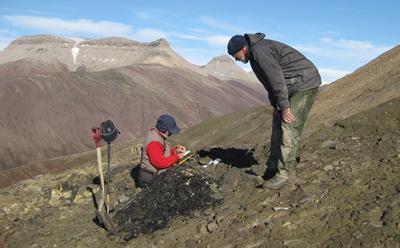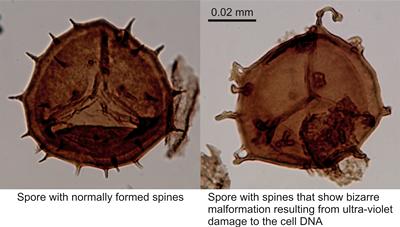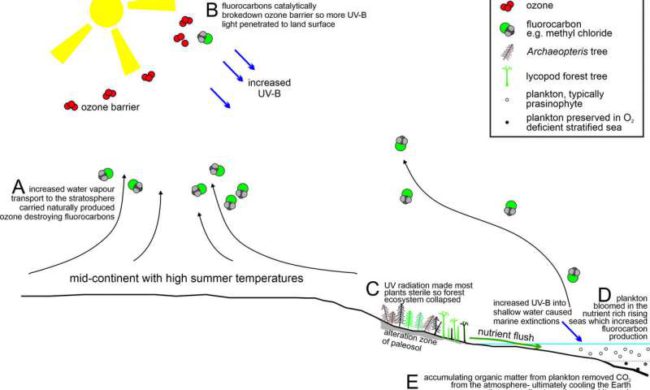
In a landmark paper published in 1982, Jack Sepkoski and David M. Raup identified five mass extinction events. Since then our understanding has grown. It has been established that multicellular animal life has experienced five major and many minor mass extinctions.
A rather obvious question is “Why did such events happen, what caused them?”. Some answers are well-known. For example the dinosaur killer event 66 million years ago was the impact of a massive comet or asteroid, but for some of the others it is not so clear. A new paper just published within Science Advances appears to have an answer for the Late Devonian extinction that happened about 360 million years ago.
The answer they have is in the title of the newly published paper.
Science Advances (May 27, 2020): UV-B radiation was the Devonian-Carboniferous boundary terrestrial extinction kill mechanism
Researchers at the University of Southampton have shown that an extinction event 360 million years ago, that killed much of the Earth’s plant and freshwater aquatic life, was caused by a brief breakdown of the ozone layer that shields the Earth from damaging ultraviolet (UV) radiation.
What did they do to reach this conclusion?
The team collected rock samples during expeditions to mountainous polar-regions in East Greenland, which once formed a huge ancient lake bed in the arid interior of the Old Red Sandstone Continent, made up of Europe and North America. This lake was situated in the Earth’s southern hemisphere and would have been similar in nature to modern day Lake Chad on the edge of the Sahara Desert.
Other rocks were collected from the Andean Mountains above Lake Titicaca in Bolivia. These South American samples were from the southern continent of Gondwana, which was closer to the Devonian South Pole. They held clues as to what was happening at the edge of the melting Devonian ice sheet, allowing a comparison between the extinction event close to the pole and close to the equator.
What did they discover from these samples?
Back in the lab, the rocks were dissolved in hydrofluoric acid, releasing microscopic plant spores (like pollen, but from fern like plants that didn’t have seeds or flowers) which had lain preserved for hundreds of millions of years. On microscopic examination, the scientists found many of the spores had bizarrely formed spines on their surface – a response to UV radiation damaging their DNA. Also, many spores had dark pigmented walls, thought to be a kind of protective ‘tan’, due to increased and damaging UV levels.

The scientists concluded that, during a time of rapid global warming, the ozone layer collapsed for a short period, exposing life on Earth to harmful levels of UV radiation and triggering a mass extinction event on land and in shallow water at the Devonian-Carboniferous boundary.
What do they think happened?
Following melting of the ice sheets, the climate was very warm, with the increased heat above continents pushing more naturally generated ozone destroying chemicals into the upper atmosphere. This let in high levels of UV-B radiation for several thousand years.
Lead researcher Professor John Marshall, of the University of Southampton’s School of Ocean and Earth Science, who is a National Geographic Explorer, comments:
“Our ozone shield vanished for a short time in this ancient period, coinciding with a brief and quick warming of the Earth. Our ozone layer is naturally in a state of flux – constantly being created and lost – and we have shown this happened in the past too, without a catalyst such as a continental scale volcanic eruption.”
During the extinction, plants selectively survived, but were enormously disrupted as the forest ecosystem collapsed. The dominant group of armoured fish became extinct. Those that survived – sharks and bony fish – remain to this day the dominant fish in our ecosystems.
These extinctions came at a key time for the evolution of our own ancestors, the tetrapods. These early tetrapods are fish that evolved to have limbs rather than fins, but still mostly lived in water. Their limbs possessed many fingers and toes. The extinction reset the direction of their evolution with the post-extinction survivors being terrestrial and with the number of fingers and toes reduced to five.

There are serious implications here for us today
Professor Marshall says his team’s findings have startling implications for life on Earth today:
“Current estimates suggest we will reach similar global temperatures to those of 360 million years ago, with the possibility that a similar collapse of the ozone layer could occur again, exposing surface and shallow sea life to deadly radiation. This would move us from the current state of climate change, to a climate emergency.”
Further Reading – Extinction via UV-B
- Science Advances (May 27, 2020): UV-B radiation was the Devonian-Carboniferous boundary terrestrial extinction kill mechanism
- University Press Release: Study shows erosion of ozone layer responsible for mass extinction event
